-
Posts
101 -
Joined
-
Last visited
Content Type
Profiles
Forums
Blogs
Gallery
Events
Store
Posts posted by JoeW
-
-
Nice medal bar. Seem to be many of the 10 and 15 year in various groupings. I have a couple or three, usually associated with a GPB. Here are a couple. The first is the medal bar of SS-OGF Fritz Weitzel shown in the photo of him wearing it and his Italian award as a Grand Officer of the Order of Sts. Maurice and Lazarus. The cased PPK was a birthday present to him from RFSS Himmler in 1939 and is so noted on the inscription plate. Sadly, no GPB. According to party documentation, it was sent to his family but lost.

The second is a short medal bar of 10 and 15 year NSDAP Long Service belonging to SS-SF and Stellenleiter der Reichsleitung Anton Hartmann, along with the accompanying ribbon bar and his small GPB shown in the photo of him from his SS officer file.
0 -
On 25/05/2009 at 03:34, Deruelle said:
Hello everybody,
I'm looking for information about the Coburger Abzeichen.
In Max Hans' book, this badge was created by Duke of Coburg Gotha on October, the 14th 1932 to commemorate the Adlf Hitler march of 14-15 october 1922. Only 436 men received this medal, which become on November, the 6th 1936 "Ehrenzeichen der NSDAP".
I want to know if pictures of this badge can be posted (reverse and observe), some close up, box and paper. Thanks for your help.
Do you know where I can find the list of the 436 men who received it?
Christophe
I am not familiar with Max Hans's book, but period documentation indicates the design was created by Hitler himself when advised of the proposed tenth anniversary celebration of the march. The local Coburg NSDAP organization put the show together and provided the awards. Hitler was present for a speech, then left. The awards were presented by a senior SA officer. It is unknown how many participants in the march were at the award ceremony. The OSAF published a list of awardees some years after the event. Sorry for the sketchy information, but I posted on the other forum mentioned and the file is away somewhere.
1 -
I think the two crowns represent the grade of Grand Officer of the Order of St. Maurice and Lazarus. Weitzel had two crowns on his ribbon bar and was not awarded the order of the Crown as we discovered in researching his service.
Sadly no foreign awards are listed on Müller's SS officer file card.
0 -
I believe the first one on the left of the bottom row of ribbons is one of the degrees of the Order of St. Maurice and Lazarus, a gold crown on light green ribbon. The same style was awarded to SS OGF Fritz Weitzel as shown here in some of his ribbon bars. That particular Italian award was commonly given to German police officials such as Daluege and Heydrich, as well as Himmler. No reason Mueller wouldn't have received it.
0 -
Noted collectors and researchers Dr. Libro Di Zinno and Rudy D’Angelo have fulfilled a lifelong dream to provide solid historical information about the Italian generals and commanders of the Italian forces that comprised over half of the axis combat formations facing the Allied forces in the North African Campaign. With excellent review on this Amazon site, the book will be a welcome addition to the library of Italian collectors.
0 -
For some reason all of Michael's list of awards are in the same color as the background and are not visible unless I highlight them with the cursor. Is the trouble in my setting or what? The pistol give to Lutze was a thank-you gift from the Walther brothers for bringing the SA Shooting matches to Zella-Mehlis. Lutze did not participate in the matches.
0 -
Is the remnants of the cloth backing visible in your photo blue-grey or greenish color? I can't make it out. If the former I would say LW but Gendarmerie if the later.
0 -
On 07/11/2018 at 18:42, Bayern said:
Hello ,Yes the BGS chevrons were dark green not black . then your SB must be that of a Oberzollinspektor Landzollbeamte ,bottle green and dull aluminium . The Zollbeamten ,used bottle green and bright aluminium
So the boards did have the RFV cyphers? But the Oberzollinspek./Bezirkzoll-Kommissar boards like these as well as all Zoll boards should have green thread hash marks, not black. At least on the uniform charts I have.
0 -
I do Matt. Thank you for showing your fine example of the 333 gold version of the Ehrennadel.
0 -
Excellent photo presentation Matt. You're correct. Though the WWF is discussed in Angolia and Littlejohn, and as well in an older Patzwall issue, little is known or discussed about the award.
0 -
I was wondering if any members out there have an example of this golden DAF lapel pin in their collection. It was awarded by the DAF to the owner and factory party leader of those factories designated as Musterbetriebe after the annual national competition. There are variations in markings on the reverse that also includes the pin number. I appreciate those forum members who have already graciously provided the information of the examples in their collections. Here is my cased example.
0 -
I don't know if I would exactly call it a "Party Shooting Award". According to the text on the reverse, the medal was to commemorate a shooting event held in August-September 1933 by the Royal Private Fire Protection Association in Munich in celebration of the National Awakening of the German People (the Nazi takeover earlier in January). The organization chose to put the image of the new Chancellor on the obverse. So there is no connection to the NSDAP.
0 -
Excellent acquisition Claudio. Congradulations!
0 -
Fascinating set Gordon. And he was carrying his privately owned Cz27 [P.Mod.27 (t)]. Hi G-Man.
0 -
Alfred, these hand stamps featuring the dark/black handles and full brass heads are reproductions in my opinion. I have purchased a view of those style as well as some stamps I consider original that have light finish handles with peculiar characteristics that seem to be common to originals.
Here is a rubber stamp that I have.
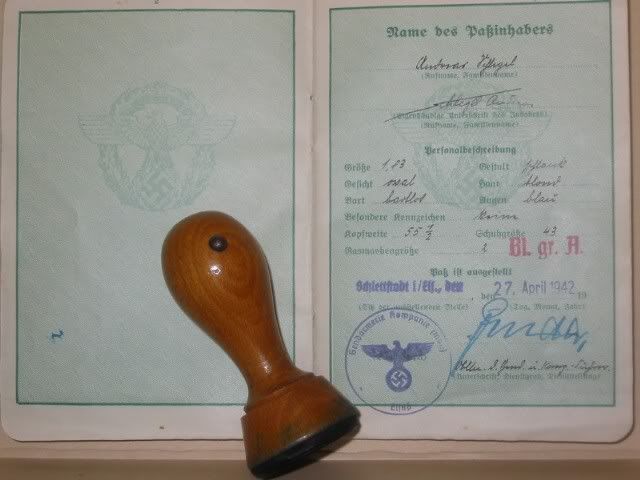 0
0 -
Ear flaps set for take-off!
Very nice info to complete the set Michael. You do marvelous work. It surely appears to be him, especially comparing the nose, cheek bone and mouth. Given the title of Generalmajor to sweeten the retirement benefits a bit.
0 -
Claudio, the Haus Orden is superb. Is there any other provenance with the medal bar to connect to Dauwel beside the order of awards? With the Haus Order it narrows the field considerably and increases the probability to almost certainty. It is a beautiful medal bar.
I believe there is a misprint in Andreas's book. According to the Police officer rank list of 1.9.41, Dauwel was promoted to Oberst d. Gendarmerie on 9.11.37. I might add that he was still an Oberst in fall 1941. He was accorded GenMaj rank on his retirement? He was married and had three children. He was a member of the NSDAP with membership number 3 266 350.
It is possible that there is information concerning Dauwel on his NSDAP membership cards. On rare occasions, a photo is added to the membership card. Microfilms of these files are maintained at the US National Archives. I might suggest you contact Mike Constandy ( mjc@westmorelandresearch.org ). I have used his services in the past for research of personalities in the captured German records of WWII in the National Archives. If you choose to use him, mention to him the NSDAP entrance date and number to assist in his search.
I will search my police magazine of 1941 and 1942 to see if I can find record of his retirement and rank appointment.
0 -
Well for sure the Internet has assisted in bringing the community of collectors together and passing knowledge on rather quickly. Thinking back to the auctions of the 1970s and 1980s, it was difficult to expand collecting brotherhood and information. Many of us were in vacuums. Was your grouping acquired from private or public auction, if you are at liberty to reveal.
0 -
Claudio, I am so very impressed with your wonderful Falke grouping. It is enormous and complex. Thank you for sharing. I was not successful in bidding for the miniatures on the Zeige auction.
I found some wonderful information on Falke's escapades in the article "Winds Over the Sinai and Palestine" by Dr. Dieter Groeschel and Juergen Ladek published in the Spring 1998 issue of the magazine "Over the Front". And of course, Falke is mentioned in some of the O'Conner books on Imperial German combat awards.
I am more a collector of material from the later periods in German history, not an avid Imperial collector, but when I saw the Ehrenbecher offered in 1989 I desired to pair it with a Luftwaffe Pokal that I had in my collection at the time and was successful at auction. I proceeded over the years to "flesh" in the person to whom the Ehrenbecher was inscribed. He was a most fascinating soldier/airman.I found an example of his Sanke card and added some examples of awards that Falke would have received to accompany the Ehrenbecher.
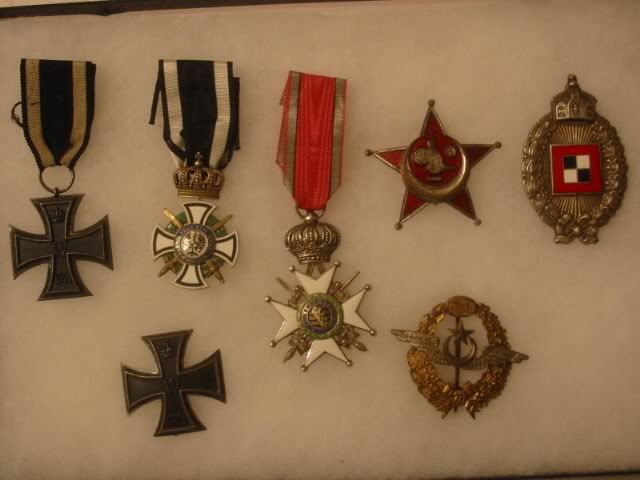
And over the years I acquired some pieces of Imperial headgear. The heavy cavalry helmets particularly impressed me, such as this Saxon Karabiner example.
 0
0 -
I purchased over two decades ago from a well-known German auction house this Ehrenbecher that was awarded to Oberleutnant Richard Falke to celebrate his first aerial victory in combat in WWI. Though he had extensive air service in Palestine after transferring from land forces where he served since earlier in WWI, as an observer he never scored a victory in combat. After his transfer to the Western Front in August 1917 as commander of Kampfstaffel 24, he finally scored his first victory in combat on September 23, 1917. This is well documented. He continued in command and combat, being transferred to BG4, until he and his pilot were shot down and captured in June 1918. He survived both wars. This is his Sanke card photo.
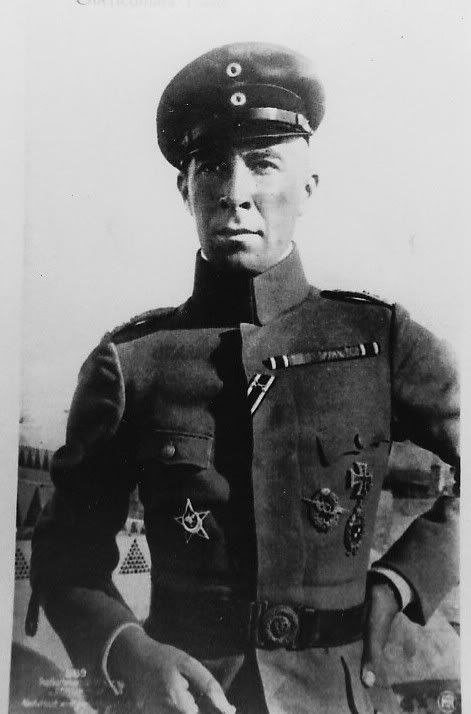
He received numerous awards and honors. Among these was this Ehrenpokal.
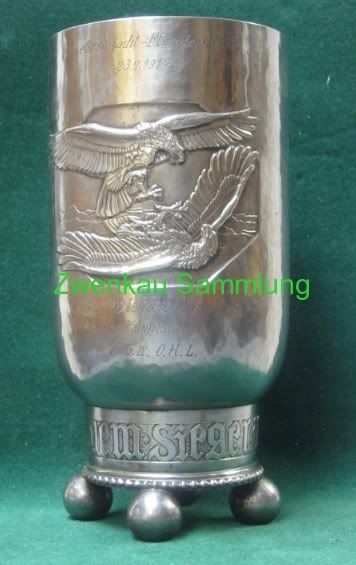
At the top is the inscription of the date and location of his first (and only) combat victory.
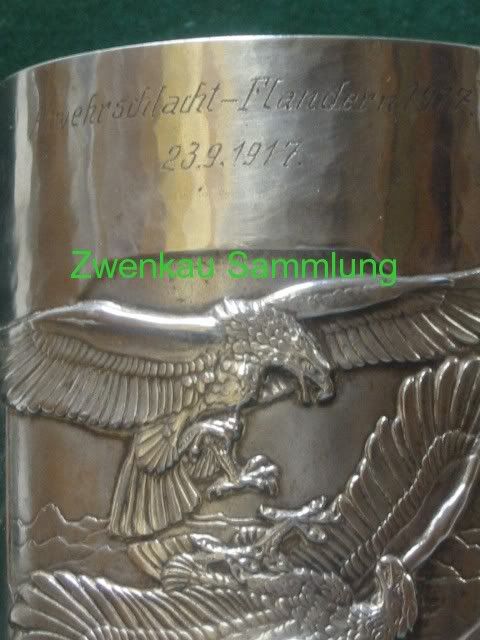
It is inscribed with his name and command at the bottom of the chalice.
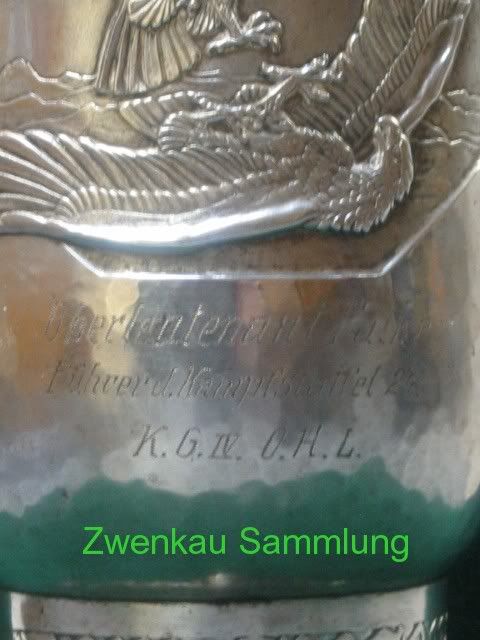
And finally on the bottom is the seal of the Commander of the German Air Services.

On the upcoming December Thies Auction, there is offered at a considerable minimum a grouping of Falke material, including the transmittal letter of the Falke Ehrenbecher and an unnamed silver Ehrenbecher purported to be the one awarded to Falke. It appears to be a correct silver Ehrenbecher, but it is without inscription as are others that have been offered in the past with an without attribution to specific flyers. It is believed that Ehrenbechers conferred later in the war were of iron/steel as silver supplies were exhausted. My Falke Ehrenbecher is steel/iron composition. Included also is the notice of his award of the Imperial Austrian Flyer's badge.
Earlier this year or last year, another piece of Falke material was sold on the Zeige Auktion. It is obvious that Falke's estate was disbursed to many places, documents and respective awards separated. It would do well for a potential bidder to apprise himself of all facts before the auction.
0 -
Close-up pictures
I would describe this more as a display banner than a flag. These were mass produced for use during parades and festivities in the III Reich, hung from windows, balconies and similar locations. It is not an NSDAP flag, like those issued to Orsgruppen, Kreis or Gaues. There is really no way to determine the production date, other than to say it is probably post-1933. It seems similar in condition to others I have seen.
0 -
Gordon, the black one's would have been more suitable in the armored vehicles than the brown mot. Gendarmerie issued ones. And the black would have matched the color of the visor-less armored crash helmets that were issued to those crews too.
0 -
Crash helmets were designed for motorcycle crews of the Ordnungspolizei. The corresponded to the colors assigned to the particular branch of service: White for Traffic Police, brown for the Motorized Gendarmerie unit and black for Schutzpolizei Motorcyle Detachments. There is also pictorial evidence that the Schupo motocycle crash helmet was used by crews of the police armored detachments.
0 -
Interesting. He managed to avoid injury in combat in the air, but within a month of being on the ground with the Feldgendarmerie, he took at hit. Are you able to track where the Feldgendarme Abtlg. was stationed?
0




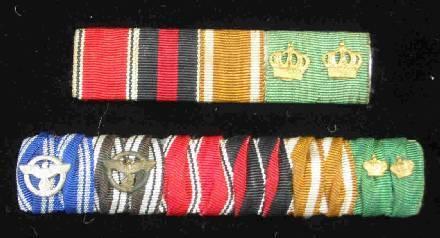
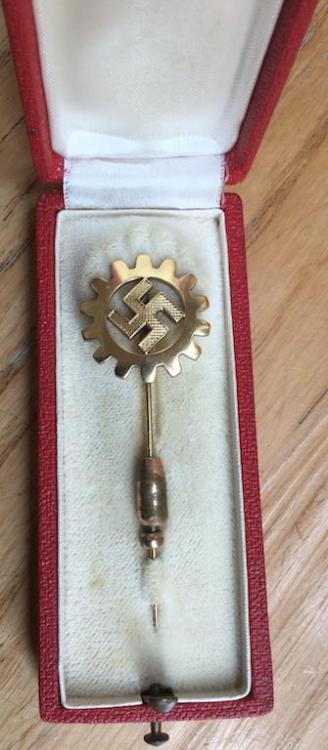
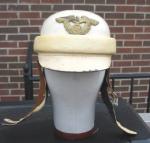
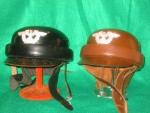
colored movie from munich 1937 - 1945
in Germany: Third Reich: State, Civil, NSDAP Awards & Decorations
Posted · Edited by JoeW
I believe this color movie came out several years ago on VHS tape which I still have. It was titled "Good Morning Mr. Hitler" and was filmed by an amateur photographer living in Munich and working with the blessing of the party. The lady in pink is Frau Ley, seated next to her husband RL Ley.